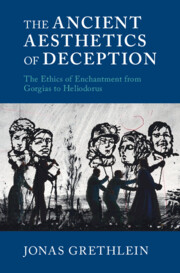Book contents
- The Ancient Aesthetics of Deception
- The Ancient Aesthetics of Deception
- Copyright page
- Contents
- List of Figures
- Acknowledgements
- Chapter 1 Gorgias and the Justice of Tragic Apatē
- Chapter 2 The Circulation and Significance of Apatē in the Classical Era
- Chapter 3 The Dramatic Entanglement of Aesthetic Illusion with Deceit in Sophocles’ Electra
- Chapter 4 Immersion and Corruption in Plato’s Republic
- Chapter 5 The Void of Hellenistic Criticism
- Chapter 6 The Appeal and Challenge of Apatē in Imperial Criticism: Plutarch’s De audiendis poetis
- Chapter 7 Lucian and the Spell of Philosophy
- Chapter 8 How to Read Ekphrasis: The Tabula Cebetis
- Chapter 9 Christian Polemics against Idolatry: Clement of Alexandria’s Protrepticus
- Chapter 10 The Aesthetics of Deception Reconfigured in Heliodorus’ Ethiopica
- Chapter 11 From Deepfake to Psychotherapy: The Aesthetics of Deception Today
- Bibliography
- Index Locorum
- General Index
Chapter 2 - The Circulation and Significance of Apatē in the Classical Era
Published online by Cambridge University Press: 23 August 2021
- The Ancient Aesthetics of Deception
- The Ancient Aesthetics of Deception
- Copyright page
- Contents
- List of Figures
- Acknowledgements
- Chapter 1 Gorgias and the Justice of Tragic Apatē
- Chapter 2 The Circulation and Significance of Apatē in the Classical Era
- Chapter 3 The Dramatic Entanglement of Aesthetic Illusion with Deceit in Sophocles’ Electra
- Chapter 4 Immersion and Corruption in Plato’s Republic
- Chapter 5 The Void of Hellenistic Criticism
- Chapter 6 The Appeal and Challenge of Apatē in Imperial Criticism: Plutarch’s De audiendis poetis
- Chapter 7 Lucian and the Spell of Philosophy
- Chapter 8 How to Read Ekphrasis: The Tabula Cebetis
- Chapter 9 Christian Polemics against Idolatry: Clement of Alexandria’s Protrepticus
- Chapter 10 The Aesthetics of Deception Reconfigured in Heliodorus’ Ethiopica
- Chapter 11 From Deepfake to Psychotherapy: The Aesthetics of Deception Today
- Bibliography
- Index Locorum
- General Index
Summary
In the second chapter, I first present other texts from the Classical period that use apatē to signify the effect of theatre and other forms of representation. These texts give evidence for the wide circulation of apatē as an aesthetic term, perhaps – this is my tentative suggestion – as a result of a Gorgianic coinage. Then, I critically examine the tendency to view Gorgias fr. 23 DK merely as paving the way for Aristotle’s Poetics. This view is in danger of confounding aesthetic illusion with fictionality and ignores the salience of apatē’s enmeshing of aesthetics with ethics.
Keywords
- Type
- Chapter
- Information
- The Ancient Aesthetics of DeceptionThe Ethics of Enchantment from Gorgias to Heliodorus, pp. 33 - 50Publisher: Cambridge University PressPrint publication year: 2021

